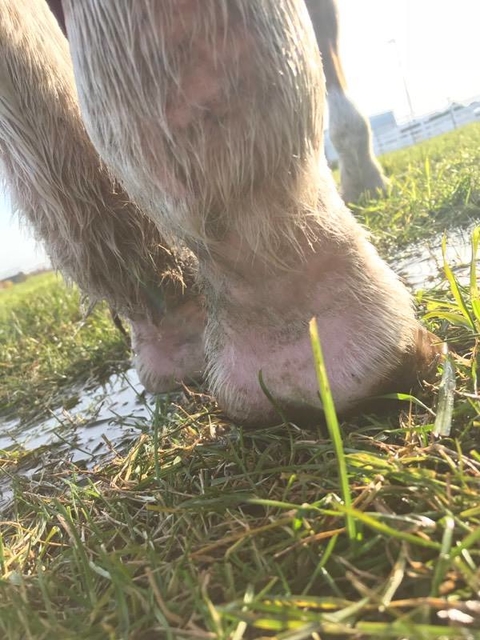Quick facts
-
Scratches refers to irritated or infected skin on the pastern or heel bulbs.
-
These conditions often occur from horses being exposed to moisture (e.g. mud, wet bedding) for a long time.
-
You can treat mild cases by washing the affected area and keeping it clean and dry.
-
Severe cases may require a veterinarian’s consult and treatment with antibiotics, an antifungal and dexamethasone.
What is scratches?
Scratches can refer to several skin conditions that occur on the back of a horse’s pasterns or bulbs of the heel.
Causes and signs
Scratches often occurs in horses exposed to moisture for a long time such as a muddy field or wet stall. Constant moisture can irritate delicate skin and cause inflammation, redness and ulcers. Coupled with mud or dirty surroundings, makes it ideal for bacteria or fungi to invade.
If the leg becomes hot, swollen and painful, contact your veterinarian. These signs mean the infection has become more serious.
Treatment
Mild cases are usually amenable to simple cleaning and topical treatment. Consult your veterinarian for treating more severe cases.
Most cases of scratches benefit from the following steps.
-
Clip the long hair from the affected skin. This will make it easier to keep clean and dry.
-
Wash the area thoroughly but gently. Make sure to remove dirt but be careful to not aggravate the skin.
-
Do a single cleaning with an antibacterial soap such as Betadine scrub. Don’t subject the skin to repeated treatments with harsh cleansers or disinfectants.
-
Lightly towel dry the area.
-
If scabs and crusts are present, try to soak or sweat them off rather than picking them, which seems to aggravate the swelling.
Limit your washing sessions to once daily. Adding moisture could further inflame the area. Try to keep your horse out of muddy or wet places and make sure that their bedding is clean and dry.
In the future, avoid hosing your horse's fetlocks and pasterns, unless you have a specific reason, and always make sure to completely dry the area afterwards. You should thoroughly clean any hobbles, boots, or wraps before you use them again.
Topical treatments
After cleaning a mild case, you may apply a modest amount of Corona ointment. This ointment isn’t water soluble and can attract dirt. Don’t use it on horses turned out on a dry-lot or muddy area. Corona is useful if the horse is stalled during treatment, as it keeps the skin soft and prevents it from splitting open.
More severe cases often require topical treatment with cream that contains both antibiotics, an antifungal agent and dexamethasone to reduce swelling. Really severe cases often benefit from a course of treatment with oral broad-spectrum antibiotics.
Reviewed in 2021


